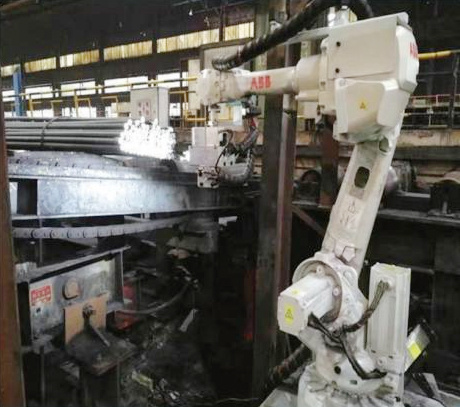PRODUCTS
Products
Welding Mark Robot System
Classification:
Key words:
 In view of the poor working environment in the metallurgical industry, relying on heavy manual labor and backward tools to carry out high-intensity operations in high temperature, high dust, high noise, and high-risk environments, there are problems such as high safety risks, low efficiency, and low accuracy. Combined with the use of the production site Situation and technical requirements, a functional robot system for welding signs is developed.
In view of the poor working environment in the metallurgical industry, relying on heavy manual labor and backward tools to carry out high-intensity operations in high temperature, high dust, high noise, and high-risk environments, there are problems such as high safety risks, low efficiency, and low accuracy. Combined with the use of the production site Situation and technical requirements, a functional robot system for welding signs is developed.
System features
▶Can communicate with Party A's on-site inventory management system, automatically obtain label printing data, and realize automatic label printing;
▶Through the in-place detection system, interlock with the-level roller table chain control system, automatically stop to the welding mark position;
▶Through the visual positioning system, accurately find the position of the welding card and realize the automatic welding card;
▶Automatic re-inspection after the completion of the welding mark, if the welding is unsuccessful or the sign falls off, the system will give an alarm and automatically repair welding;
▶After welding, communicate with the primary automation system to release the chain lock signal, and the steel bundle is transported to the next process through the chain;
▶Real-time monitoring of the operation of the system, real-time alarm of abnormal conditions, accurate positioning of fault alarm points;
▶Through remote monitoring, the real-time collection and rapid concentration of the operating data of the on-site robot automatic welding mark control system can be realized, and the technical personnel can remotely monitor the various parameters and operating status of the system.
Main functions of the system
The robot automatic welding mark system applies the personalized design concept of machine vision control technology, establishes the workpiece model according to the user's workpiece, determines the structure form of the robot workstation according to the workpiece model and welding point, and uses machine vision to accurately locate the welding point. The functions of automatic transmission of label data through MES system, automatic detection of rebar position by machine vision, automatic nail taking, automatic printing, automatic label suction, automatic label welding, automatic detection of successful label welding and other functions are realized, which meet the requirements of flexible and convenient use and replace the complicated, repetitive and dangerous welding label work.
Previous Page
Next Page
Your suggestion is our driving force
Related Products
The transformer dynamic load intelligent management system is used to solve the problems of low operating efficiency of large transformers, difficulty in internal temperature monitoring, and limited operation of transformers under heavy (over) load, and to improve the operating efficiency of transformers without affecting the service life and safe operation of transformers.
The dynamic load management system of transmission line is used to solve the problems such as limited load capacity of transmission line and difficult to meet the demand of load growth, and to improve the operation level and load capacity of the line without changing the existing network structure and without affecting the thermal stability of the line.
Due to the technical limitations of the traditional transmission line fault location device, it is difficult to quickly and accurately locate the fault point and identify the fault type when the fault of the transmission line occurs in the complex operating environment (lightning strike, mountain fire, wind deviation, tree barrier, floating object, etc.). The distributed fault diagnosis device for transmission lines is based on fault local recording technology and traveling wave location method, which can effectively solve the problems of low positioning accuracy and difficult identification of fault types of traditional fault location devices.

